Anita O’Day
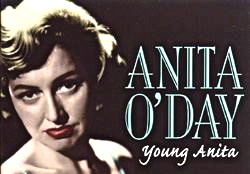
Anita O’Day performing at Newport Jazz Festival
Anita performing “Sweet Georgia Brown” and “Tea for Two” at Newport Jazz Festival in 1958.
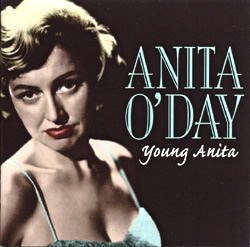 Anita O’Day (born October 18, 1919 – died November 23, 2006) was an American jazz singer.
Anita O’Day (born October 18, 1919 – died November 23, 2006) was an American jazz singer.
Born Anita Belle Colton, O’Day was admired for her sense of rhythm and dynamics, and her early big band appearances shattered the traditional image of the “girl singer.” Refusing to pander to any female stereotype, O’Day presented herself as a “hip” jazz musician, wearing a band jacket and skirt as opposed to an evening gown. She changed her surname from Colton to O’Day, pig Latin for “dough,” slang for money.
Style
O’Day, along with Mel Tormé, is often grouped with the West Coast cool school of jazz. Like Tormé, O’Day had some training in jazz drums (courtesy of her first husband Don Carter); her longest musical collaboration was with jazz drummer John Poole. While maintaining a central core of hard swing, O’Day’s skills in improvisation of rhythm and melody put her squarely among the pioneers of bebop.
She cited Martha Raye as the primary influence on her vocal style, also expressing admiration for Mildred Bailey, Ella Fitzgerald, and Billie Holiday. She always maintained that the accidental excision of her uvula during a childhood tonsillectomy left her incapable of vibrato, and unable to maintain long phrases. That botched operation, she claimed, forced her to develop a more percussive style based on short notes and rhythmic drive. However, when she was in good voice she could stretch long notes with strong crescendos and a telescoping vibrato, e.g. her live version of “Sweet Georgia Brown” at the 1958 Newport Jazz Festival, captured in Bert Stern’s film Jazz on a Summer’s Day.
Early Career
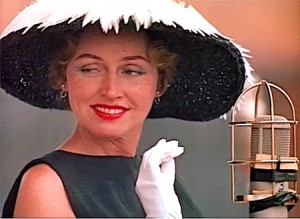 Born to James and Gladys M. (née Gill) Colton in Chicago, Anita Belle Colton (who later took the surname “O’Day”) took the first chance to leave her unhappy home when, at age 14, she became a contestant in the popular Walk-a-thons as a dancer. She toured with the Walk-a-thons circuits for two years, occasionally being called upon to sing. In 1934, she began touring the Midwest as a marathon dance contestant and singing “The Lady in Red” for tips.
Born to James and Gladys M. (née Gill) Colton in Chicago, Anita Belle Colton (who later took the surname “O’Day”) took the first chance to leave her unhappy home when, at age 14, she became a contestant in the popular Walk-a-thons as a dancer. She toured with the Walk-a-thons circuits for two years, occasionally being called upon to sing. In 1934, she began touring the Midwest as a marathon dance contestant and singing “The Lady in Red” for tips.
In 1936, she left the endurance contests, determined to become a professional singer. She started out as a chorus girl in such Uptown venues as the Celebrity Club and the Vanity Fair, then found work as a singer and waitress at the Ball of Fire, the Vialago, and the Planet Mars. At the Vialago, O’Day met the drummer Don Carter, who introduced her to music theory; they wed in 1937. Her first big break came in 1938 when Down Beat editor Carl Cons hired her to work at his new club at 222 North State Street, the Off-Beat, which became a popular hangout for musicians. Also performing at the Off-Beat was the Max Miller Quartet, which backed O’Day for the first ten days of her stay there. While performing at the Off Beat, she met Gene Krupa, who promised to call her if Irene Daye, then his vocalist, ever left his band, and in 1939, O’Day was hired as vocalist for Miller’s Quartet, which had a stay at the Three Deuces club in Chicago.
Work with Krupa, Herman, and Kenton
The call from Krupa came in early 1941. Of the 34 sides she recorded with Krupa, it was “Let Me Off Uptown,” a novelty duet with Roy Eldridge, that became her first big hit. That same year, Down Beat named O’Day “New Star of the Year.” In 1942, she appeared with the Krupa band in two “soundies” (short musical films originally made for jukeboxes), singing “Thanks for the Boogie Ride” and “Let Me Off Uptown.” The same year Down Beat magazine readers voted her into the top five big band singers. O’Day came in fourth, with Helen O’Connell first, Helen Forrest second, Billie Holiday third, and Dinah Shore fifth. O’Day married golf pro and jazz fan Carl Hoff in 1942.
When Krupa’s band broke up after he was arrested for possession of marijuana in 1943, O’Day joined Woody Herman for a month-long gig at the Hollywood Palladium, followed by two weeks at the Orpheum. Unwilling to tour with another big band, she left Herman after the Orpheum engagement and finished out the year as a solo artist. Despite her initial misgivings about the compatibility of their musical styles, she joined Stan Kenton’s band in April 1944. During her 11 months with Kenton, O’Day recorded 21 sides, both transcription and commercial, and appeared in a Universal Pictures short Artistry in Rhythm (1944). “And Her Tears Flowed Like Wine” became a huge seller and put Kenton’s band on the map. She also appeared in one soundie with Kenton, performing “I’m Going Mad for a Pad” and “Tabby the Cat.” O’Day later said, “My time with Stanley helped nurture and cultivate my innate sense of chord structure.” In 1945 she rejoined Krupa’s band and stayed almost a year. The reunion yielded only 10 sides. After leaving Krupa late in 1946, O’Day once again became a solo artist.
Post-War Work
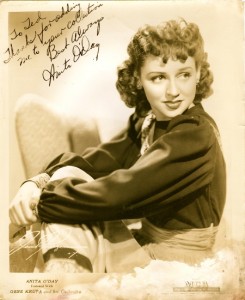 During the late 1940’s, she recorded two dozen sides, mostly for small labels. The quality of these singles varies: O’Day was trying to achieve popular success without sacrificing her identity as a jazz singer. Among the more notable recordings from this period are “Hi Ho Trailus Boot Whip,” “Key Largo,” “How High the Moon,” and “Malaguena.” O’Day’s drug problems began to surface late in 1947, when she and Hoff were arrested for possession of marijuana and sentenced to 90 days in jail. Her career was back on the upswing in September 1948, when she sang with Count Basie at the Royal Roost in New York City, resulting in five airchecks. What secured O’Day’s place in the jazz pantheon, however, were the 17 albums she recorded for Norman Granz’s Norgran and Verve labels between 1952 and 1962.
During the late 1940’s, she recorded two dozen sides, mostly for small labels. The quality of these singles varies: O’Day was trying to achieve popular success without sacrificing her identity as a jazz singer. Among the more notable recordings from this period are “Hi Ho Trailus Boot Whip,” “Key Largo,” “How High the Moon,” and “Malaguena.” O’Day’s drug problems began to surface late in 1947, when she and Hoff were arrested for possession of marijuana and sentenced to 90 days in jail. Her career was back on the upswing in September 1948, when she sang with Count Basie at the Royal Roost in New York City, resulting in five airchecks. What secured O’Day’s place in the jazz pantheon, however, were the 17 albums she recorded for Norman Granz’s Norgran and Verve labels between 1952 and 1962.
Her first album, Anita O’Day Sings Jazz (reissued as The Lady Is a Tramp), was recorded in 1952 for the newly established Norgran Records (it was also the label’s first LP). The album was a critical success and further boosted her popularity. In October 1952, O’Day was again arrested for possession of marijuana, but found not guilty. The following March, she was arrested for possession of heroin. The case dragged on for most of 1953; O’Day was finally sentenced to six months in jail. Soon after her release from jail on February 25, 1954, she began work on her second album, Songs by Anita O’Day (reissued as An Evening with Anita O’Day). She recorded steadily throughout the 1950’s, accompanied by small combos and big bands. In person, O’Day was generally backed by a trio which included John Poole, the drummer with whom she would work for the next 40 years. As a live performer O’Day also began performing in festivals and concerts with such musicians as Louis Armstrong, Oscar Peterson, Dinah Washington, George Shearing, Cal Tjader and Thelonious Monk. She appeared in the documentary Jazz on a Summer’s Day, filmed at the 1958 Newport Jazz Festival, which increased her popularity. She admitted later that she was probably high on heroin during the concert. She also said that it was the best day of her life in that hers was the star performance of the festival and she made the cover of national magazines for it.
Anita O’Day in 2005
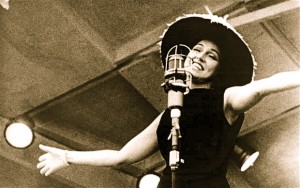 The following year, O’Day made a cameo appearance in The Gene Krupa Story, singing “Memories of You.” Late in 1959, she toured Europe with Benny Goodman to great personal acclaim. O’Day wrote in her 1981 autobiography that when Goodman’s attempts to upstage her failed to diminish the audience’s enthusiasm, he cut all but two of her numbers from the show.
The following year, O’Day made a cameo appearance in The Gene Krupa Story, singing “Memories of You.” Late in 1959, she toured Europe with Benny Goodman to great personal acclaim. O’Day wrote in her 1981 autobiography that when Goodman’s attempts to upstage her failed to diminish the audience’s enthusiasm, he cut all but two of her numbers from the show.
O’Day went back to touring as a solo artist and appeared on such TV specials as the Timex All-Star Jazz Show and The Swingin’ Years hosted by Ronald Reagan. She recorded infrequently after the expiration of her Verve contract in 1962 and her career seemed over when she nearly died of a heroin overdose in 1968. After kicking the habit, she made a comeback at the 1970 Berlin Jazz Festival. She also appeared in the films Zigzag a.k.a. False Witness with George Kennedy (1970) and The Outfit (1974) with Robert Duvall. She resumed making live and studio albums under the new management of Alan Eichler, many recorded in Japan, and several were released on Emily Records, owned by Anita O’Day and John Poole. Since then, Emily Records has changed its name to Emily Productions, now owned by Elaine Poole, and they are currently restoring Anita’s live and studio archives from the Emily years
Memoir and later life
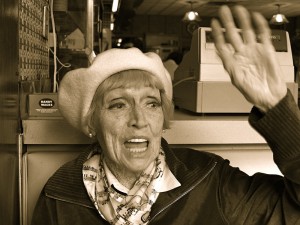 In November 1980 she was a headliner along with Clark Terry, Lionel Hampton and Ramsey Lewis during the opening two-week ceremony performances celebrating the short-lived resurgence of the Blue Note Lounge at the Marriott O’Hare Hotel near Chicago.
In November 1980 she was a headliner along with Clark Terry, Lionel Hampton and Ramsey Lewis during the opening two-week ceremony performances celebrating the short-lived resurgence of the Blue Note Lounge at the Marriott O’Hare Hotel near Chicago.
O’Day spoke candidly about her drug addiction in her 1981 memoir High Times, Hard Times, which led to a string of TV appearances on 60 Minutes, The Tonight Show Starring Johnny Carson, The Today Show with Bryant Gumbel, The Dick Cavett Show, Over Easy with Hugh Downs, The Tomorrow Show with Tom Snyder, and several others. She toured Europe, and also performed a 50th Anniversary Concert (1985) at Carnegie Hall which resulted in the (2010) release of “Anita O’Day – Big Band at Carnegie Hall – Emily Productions.” O’Day also headlined New York’s JVC Jazz Festival.
In 2005, her version of the standard “Sing, Sing, Sing” was remixed by RSL and was included in the compilation album Verve Remixed 3. The following year, she released Indestructible!, her first album in 13 years.
One of her best-known late-career audio performances is “Is You Is Or Is You Ain’t My Baby”, which opens the film Shortbus (2006) by John Cameron Mitchell.
A feature-length documentary, Anita O’Day: The Life of a Jazz Singer, directed by Robbie Cavolina and Ian McCrudden, premiered at the Tribeca Film Festival on April 30, 2007.
In November 2006, Robbie Cavolina (her last manager) entered her into a West Hollywood, California convalescent hospital, while she recovered from pneumonia. Two days before her death, she had demanded to be released from the hospital. On Thanksgiving Day, November 23, 2006, at age 87, O’Day died in her sleep. The official cause of death was cardiac arrest.
Discography
Anita O’Day discography
Filmography
The Gene Krupa Story (1959)
Zigzag (1970)
The Outfit (1973)
Shortbus (2006)
Documentary
Jazz on a Summer’s Day (1960)
Anita O’Day – Live at Ronnie Scott’s (2006)
Anita O’Day: The Life of a Jazz Singer (2007)
Live In Tokyo ’63 (2007)
Jazz Icons (2009)

